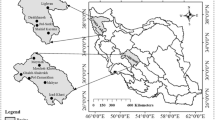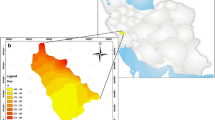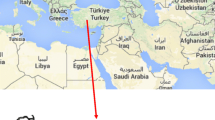Abstract
This study was conducted using gene expression programming (GEP) and an adaptive neural-based fuzzy inference system (ANFIS) as an alternative approach to estimate daily pan evaporation, which is an important parameter in hydrological and meteorological studies. The input parameters used to estimate daily pan evaporation from Lake Eğirdir in the southwestern part of Turkey are the daily pan evaporation data of Lake Kovada (Ko t ) and Lake Karacaören Dam (Ka t ) and the previous 1-, 2-, and 3-day pan evaporation values of Lake Eğirdir. The various input combinations were tried by using pan evaporation data for the years 1998–2005. The GEP model with the highest Nash–Sutcliffe efficiency and the lowest mean square error have the daily pan evaporation data of Lake Kovada (Ko t ) and Lake Karacaören Dam (Ka t ) and the previous 1-day pan evaporation values of Lake Eğirdir. The NSE of the best GEP model was obtained as 0.729, 0.722, and 0.701 for training, testing, and validation sets, respectively. Furthermore, the ANFIS models were developed using the same input combinations. It was seen that the GEP model was more superior to the ANFIS model.









Similar content being viewed by others
References
Abtew W (2001) Evaporation estimation for Lake Okeechobee in South Florida. J Irrig Drain Eng 127(3):140–147
Bazarseren B, Hildebrandt G, Holz KP (2003) Short-term water level prediction using neural networks and neuro-fuzzy approach. Neurocomputing 55(3–4):439–450
Chang CL, Lo SL, Yu SL (2005) Applying fuzzy theory and genetic algorithm to interpolate precipitation. J Hydrol 314:92–104
Chang L-C, Chang F-J (2001) Intelligent control for modeling of real-time reservoir operation. Hydrol Process 15:1621–1634
Cheng CT, Ou CP, Chau KW (2002) Combining a fuzzy optimal model with a genetic algorithm to solve multi-objective rainfall–runoff model calibration. J Hydrol 268:72–86
Choudhury BJ (1999) Evaluation of an empirical equation for annual evaporation using field observations and results from a biophysical model. J Hydrol 216:99–110
Ferreira C (2001) Gene expression programming: a new adaptive algorithm for solving problems. Complex Syst 13(2):87–129
Ferreira C (2002) Gene expression programming in problem solving. In: Roy R, Ovaska S, Furuhashi T, Hoffman F (eds) Soft computing and industry-recent applications. Springer, Berlin, pp 635–654
Ferreira C (2006) Gene-expression programming: mathematical modeling by an artificial intelligence. Springer, Berlin
Fırat M, Güngör M (2007) River flow estimation using adaptive neuro fuzzy inference system. Math Comput Simul 75:87–96
Frankenberger JR, Brooks ES, Walter MT, Walter MF, Steenhuis TS (1999) A GIS-based variable source area hydrology model. Hydrol Process 13:805–822
Ghorbani MA, Khatibi R, Aytek A, Makarynskyy O, Shiri J (2010) Sea water level forecasting using genetic programming and comparing the performance with artificial neural networks. Comput Geosci 36:620–627
Gupta HV, Kling H, Yılmaz KK, Martinez GF (2009) Decomposition of the mean squared error and NSE performance criteria: implications for improving hydrological modeling. J Hydrol 377:80–91
Güven A, Aytek A (2009) New approach for stage–discharge relationship: gene-expression programming. J Hydrol Eng 14(8):812–820
Güven A, Kişi Ö (2011) Daily pan evaporation modeling using linear genetic programming technique. Irrig Sci 29:135–145
Ikebuchi S, Seki M, Ohtoh A (1988) Evaporation from Lake Biwa. J Hydrol 102:427–449
Jang JSR (1992) Self-learning fuzzy controllers based on temporal back propagation. IEEE Trans Neural Netw 3(5):714–723
Keskin ME, Taylan ED (2009) Artificial models for inter-basin flow prediction in southern Turkey. J Hydrol Eng 14(7):752–758
Keskin ME, Terzi Ö (2006) Artificial neural network models of daily pan evaporation. J Hydrol Eng 11(1):65–70
Keskin ME, Terzi Ö, Taylan ED (2004) Fuzzy logic model approaches to daily pan evaporation estimation in western Turkey. Hydrol Sci J 49(6):1001–1010
Keskin ME, Terzi Ö, Taylan D (2009) Estimating daily pan evaporation using adaptive neural-based fuzzy inference system. Theor Appl Climatol 98(1–2):79–87
Keskin ME, Terzi Ö, Küçüksille E (2009) Data mining process for integrated evaporation model. J Irrig Drain Eng 135(1):39–43
Kişi Ö (2006) Daily pan evaporation modelling using a neuro-fuzzy computing technique. J Hydrol 329:636–646
Krause P, Boyle DP, Base F (2005) Comparison of different efficiency criteria for hydrological model assessment. Adv Geosci 5:89–97
Koza JR (1992) Genetic programming on the programming of computers by means of natural selection. A Bradford book. The MIT Press, Cambridge
Lin CT, Lee CSG (1995) Neural fuzzy systems: a neuro-fuzzy synergism to intelligent systems. Prentice Hall, Englewood Cliffs, p 797
Makkeasorn A, Chang NB, Zhou X (2008) Short-term streamflow forecasting with global climate change implications—a comparative study between genetic programming and neural network models. J Hydrol 352:336–354
McCuen RH, Knight Z, Cutter AG (2006) Evaluation of the Nash-Sutcliffe efficiency. J Hydrol Eng 11(6):597–602
McKenzie RS, Craig AR (2001) Evaluation of river losses from the Orange River using hydraulic modeling. J Hydrol 241:62–69
Murphy A (1988) Skill scores based on the mean square error and their relationships to the correlation coefficient. Mon Weather Rev 116:2417–2424
Nash JE, Sutcliffe JV (1970) River flow forecasting through. Part I. A conceptual models discussion of principles. J Hydrol 10:282–290
Nayak PC, Sudheer KP, Rangan DM, Ramasastr KS (2004) A neuro-fuzzy computing technique for modeling hydrological time series. J Hydrol 291(1–2):52–66
Ponce VM (1989) Engineering hydrology, principles and practices. Prentice-Hall, New Jersey
Rao HS, Babu BR (2006) Optimized column design using genetic algorithm based neural networks. Indian J Eng Mater Sci 13:503–511
Reddy MJ, Ghimire BNS (2009) Use of model tree and gene expression programming to predict the suspended sediment load in rivers. J Intell Syst 18(3):211–228
Saltan M, Terzi S (2005) Comparative analysis of using artificial neural networks (ANN) and gene expression programming (GEP) in backcalculation of pavement layer thickness. Indian J Eng Mater Sci 12:42–50
Savic DA, Walters GA, Davidson JW (1999) A genetic programming approach to rainfall-runoff modelling. Water Resour Manag 13:219–231
Shu C, Ouarda TBMJ (2008) Regional flood frequency analysis at ungauged sites using the adaptive neuro-fuzzy inference system. J Hydrol 349(1–2):31–43
Singh VP, Xu C-Y (1997) Evaluation and generalization of 13 mass-transfer equations for determining free water evaporation. Hydrol Process 11:311–323
Singh VP, Xu C-Y (1997) Sensitivity of mass transfer-based evaporation equations to errors in daily and monthly input data. Hydrol Process 11:1465–1473
Teegavarapu RSV, Tufail M, Ormsbee L (2009) Optimal functional forms for estimation of missing precipitation data. J Hydrol 374:106–115
Terzi Ö, Keskin ME, Taylan D (2006) Estimating evaporation using ANFIS. J Irrig Drain Eng 132(5):503–507
Tsoukalas LH, Uhrig RE (1997) Fuzzy and neural approaches in engineering. A Wiley-Interscience Publications. Wiley, New York, p 587
Vallet-Coulomb C, Legesse D, Gasse F, Travi Y, Chernet T (2001) Lake evaporation estimates in tropical Africa (Lake Ziway, Ethiopia). J Hydrol 245:1–18
Whigham PA, Crapper PF (2001) Modelling rainfall-runoff using genetic programming. Math Comput Model 33:707–721
Xu C-Y, Singh VP (2001) Evaluation and generalization of temperature-based methods for calculating evaporation. Hydrol Process 15:305–319
Zhang FX, Wai WHO, Jiang YW (2010) Prediction of sediment transportation in deep bay (Hong Kong) using genetic algorithm. J Hydrodyn 22(5):599–604
Author information
Authors and Affiliations
Corresponding author
Rights and permissions
About this article
Cite this article
Terzi, Ö. Daily pan evaporation estimation using gene expression programming and adaptive neural-based fuzzy inference system. Neural Comput & Applic 23, 1035–1044 (2013). https://doi.org/10.1007/s00521-012-1027-x
Received:
Accepted:
Published:
Issue Date:
DOI: https://doi.org/10.1007/s00521-012-1027-x




